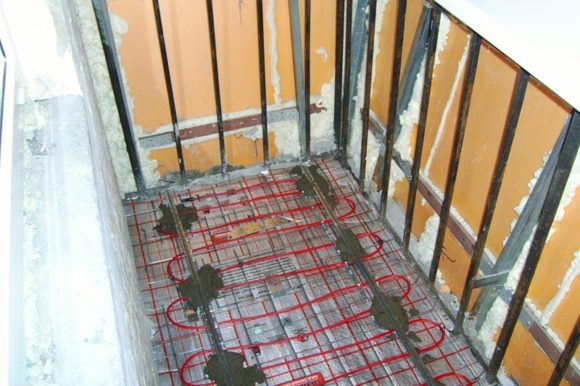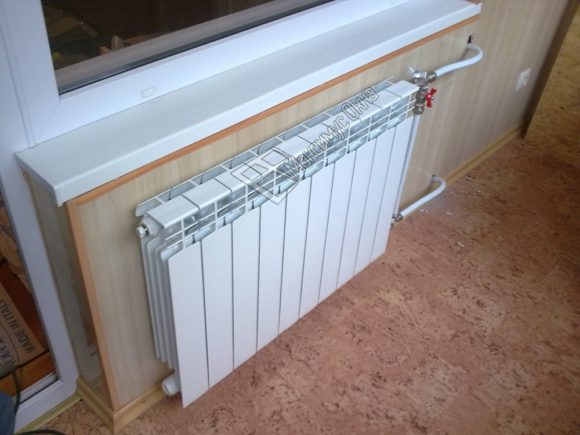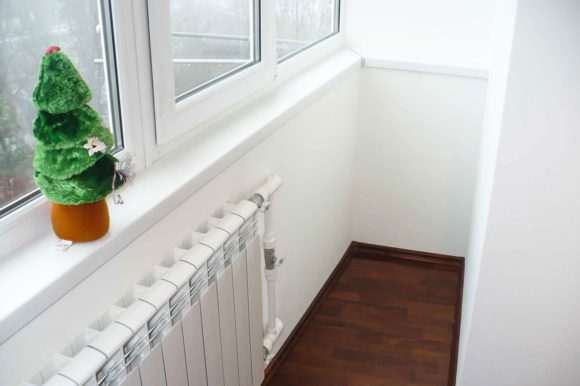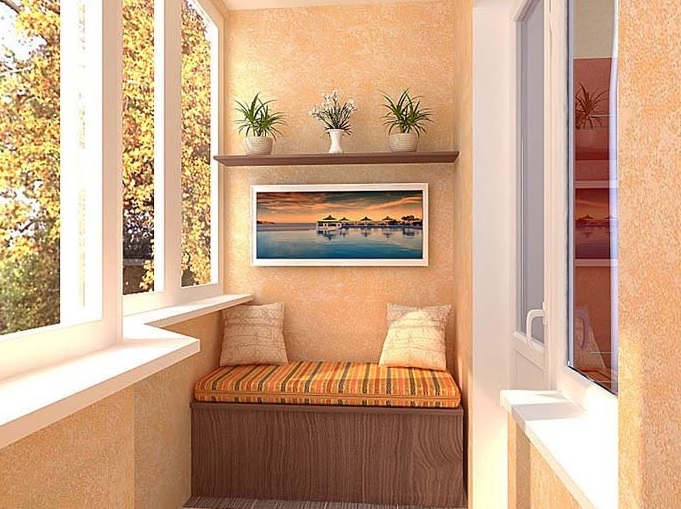Often the owners of small apartments tend to turn a balcony or loggia into a full-fledged living space. They make repairs and turn non-residential space into an ordinary room, which is used as a place to work, play or just to relax. The only obstacle to year-round use is the lack of heating. There are several ways to solve this problem.
Content
Preparing for insulation
Before warming the balcony, first study what condition the parapet is in. To equip a full room, it is first strengthened. Then install modern double-glazed windows. Additionally, they do waterproofing work, warm the room.
For wall insulation, they are laid out with brick or foam blocks. Glazing can be carried out immediately afterwards. To improve thermal insulation, it is necessary to install high-quality double-glazed windows and a profile of at least three cameras.
It is best to entrust glazing to professionals. They will evaluate the condition of the balcony, take measurements and do all the work.
All cracks between the parapet and the floor, as well as in the walls, are qualitatively closed by pouring construction foam or sealant. Protection against moisture is carried out using coating or roll waterproofing. After that, the walls and floor are sheathed with foam, mineral wool or extruded polystyrene foam to reduce heat loss.

Is it possible to insulate a balcony with steam heating
To create comfortable conditions, it is not enough just to insulate the walls. In a cold climate, without an additional source of heating, the loggia will not be comfortable. As it is, some owners tend to use central heating batteries.
According to building regulations, heating a balcony with steam heating is not permitted. There are several reasons for this:
- In winter frosts, there is a high probability of freezing and battery breakdown. Because of this, the lower floors will be flooded.
- The removal of central heating outside the apartment imposes an additional burden on the overall system of the house. Because of this, the pressure in it drops and in other rooms the air temperature drops.
- The cost of heating an apartment depends on its area, which does not include the space of a balcony and a loggia. Therefore, upon detection of an illegally installed radiator, the owners of the apartment will pay a heavy fine.
- When selling an apartment with an illegally installed additional radiator, the fraud will be revealed. Then in order to avoid punishment it will have to be dismantled.
The legal installation of an additional radiator on the balcony is fraught with difficulties, numerous trips to the authorities. Even if all documents are collected, there is no full guarantee that the installation of an additional battery will be allowed. Therefore, they often use other methods of heating the loggia.
Types of heaters
The easiest way to heat a loggia or balcony in winter without central heating is to install a heater. Most often, electrical appliances are used for this. They differ in the device and the principle of operation. Before heating the balcony in winter, take into account the size of the room and how high-quality insulation is used.A large area of the room needs a powerful heater. If the insulation and waterproofing are poor, it is generally pointless to heat it.
Fan heater
In the case of such a device, a heating element and a fan are connected. During operation, the surrounding air heats up and spreads throughout the room. Using a fan heater is appropriate if you need to heat the balcony quickly. But its constant use as a heat source is inconvenient. It makes a lot of noise during work. In addition, it must be constantly turned off and on again. Otherwise, it will overheat and fail. A plus is considered a low price. Therefore, heating with a fan heater is the cheapest way of heating.
Convector
Convector type devices force the movement of air in the room. Under its influence, the air flow is sucked in from below and leaves the device from above. He quickly heats the room to a predetermined temperature, and then turns off for a while. You can install such a heater on the wall or on the floor. The disadvantage is that it causes a strong overdry of air and greatly increases the electricity bill.
Oil heater
The heater is a metal case filled with mineral oil. Under the influence of electricity, mineral oil is first heated, and then heat is transferred to the body. This appliance only heats up to +80 degrees. It is safe and does not burn oxygen in the room, since the heater is located inside the housing. The heating of such a device occurs slowly; it also cools slowly after turning it off.

Infrared heater
The device heats the air, generating radiation in the infrared range. The rays from such a device first heat the surfaces encountered in their path, or of a person, and the surrounding air is already heated from them. Such heaters are among the most effective. They shut off electricity to heat with minimal loss.
The disadvantage of such a heater is that a thermal shadow appears. Then cluttering up the space with a large number of objects stops the rays. Then the space behind it remains cold.
Solar panels
This heating method appeared several years ago. It is especially convenient to use in a private house. You can also heat a city apartment in a multi-storey building, but installation is difficult. Due to the high cost of solar panels, this heating method cannot be called effective and economical. In addition, solar panels do not heat the air in the room on their own. They only accumulate solar energy and are able to direct it into some kind of electrical device.
Warm floor
In addition to conventional electric heaters, special systems mounted under the flooring are used for heating the space of the balcony. Such devices are called underfloor heating. There are several varieties of this design.
Heating mats
For this design, no special screed is needed. Thin plates are laid directly under the tile adhesive. The heating mats contain a special net connected to an electric cable. To protect it from damage, use a protective screen. Mats can be cut in any way, so they are convenient to use for floor heating of any shape. Such a floor is very light and almost does not increase the level of the floor. The main disadvantage of this heating method is its high cost.
Heating mats are as close to the floor as possible. Therefore, the surface heats up very quickly.
Cable floor heating
In this case, heating is carried out through an electric cable. For a device of this gender, a number of special works are performed. First, the floor is covered with foam plates and waterproofed.The next layer is laid reinforcing mesh. Then they lay the cable in a zigzag manner, fastening it with a mounting tape. From above, everything is poured with concrete 5 cm thick. Such a floor warms up the screed first, and already it gives off heat to the air in the room.

This floor heats the room slowly but evenly. For heating to be of high quality, the floor covering must be made of ceramic tiles. The disadvantage of such heating is the installation time and a significant increase in floor height. In addition, the floor dangerously increases the load on the balcony.
Infrared underfloor heating
The principle of the infrared floor is that the radiation heats all surfaces nearby. For the device of such heating, you do not need to remove the old floor or arrange a new coating. It does not burden the balcony, is not afraid of cold glass and is safe for health.
Warm baseboard
This design heats the space of the balcony well, consumes a little electricity and does not disfigure the space. A warm skirting board is a heater located on the floor surface. Such a system heats the walls and prevents the formation of condensation on them. With such heating, the air circulates very smoothly, it does not stagnate from above and does not provoke drafts.
Warm water floor
Heating is a plastic tube, which is laid on the floor in the form of a zigzag or snail. Then it is poured with a concrete screed and filled with hot water.
Then the heat distribution occurs along a convenient trajectory. Warm air is distributed from the bottom up. At the same time, the surface of the floor covering always remains warm. The advantage is that it is allowed to be installed if the pipe is not connected to central heating or water supply.
Subtleties of choosing a heater
To select a heating option, specific requirements for it are taken into account. If you do not need to constantly heat the loggia, use devices that heat the air quickly and do not maintain heat for a long time. Then use a fan heater.
To ensure that the heating is constant, all other options for electric heaters are suitable. Oil radiators heat the air evenly, without creating strong jumps. Electric convectors quickly heat the air and evenly distribute heat. In this case, convectors can be installed on any suitable plane.
To reduce energy costs, infrared heaters are used. They are not suitable for heating a room littered with furniture. All types of underfloor heating are optimally heated in the loggia and balcony in winter. Their main drawback is that for installation it is necessary to carry out repairs. To install electric heaters, this is not necessary.
Finally
Insulating a balcony and arranging full heating on it is a very difficult task. In addition, such a room can not always be fully used in severe frost, even with full heating. Therefore, it is sometimes rational to simply install a good heater on the balcony.


Alas, no comments yet. Be the first!